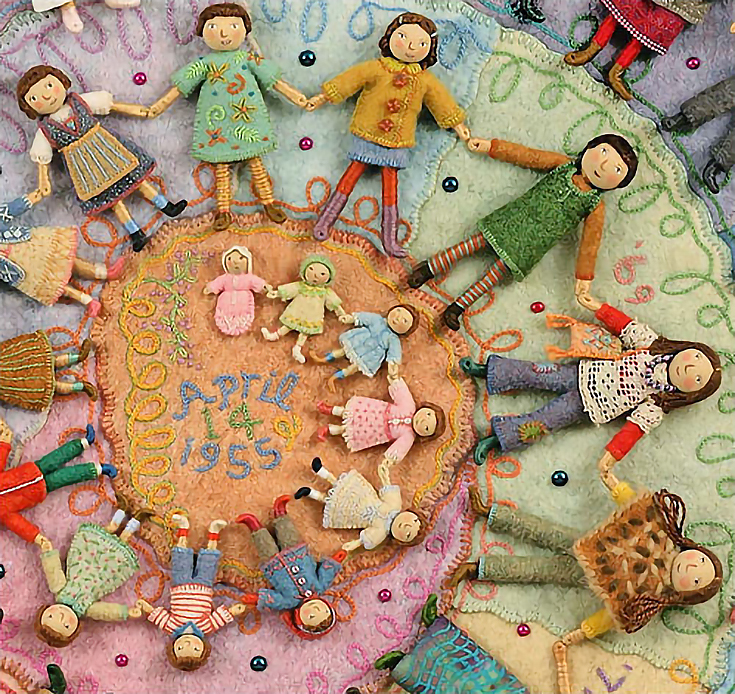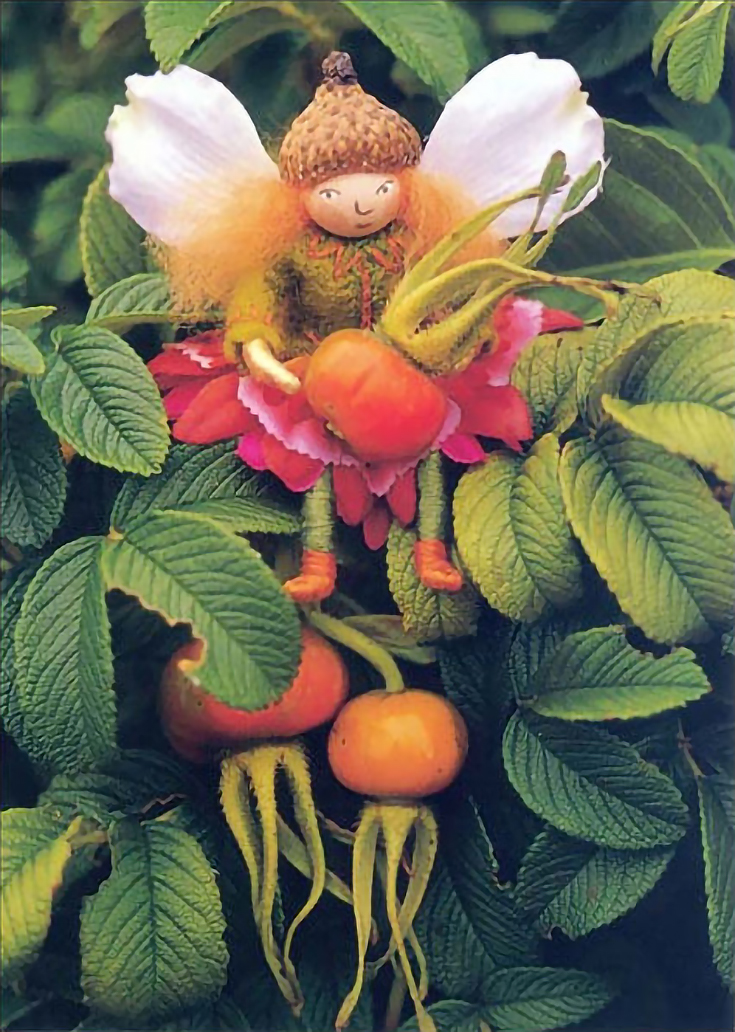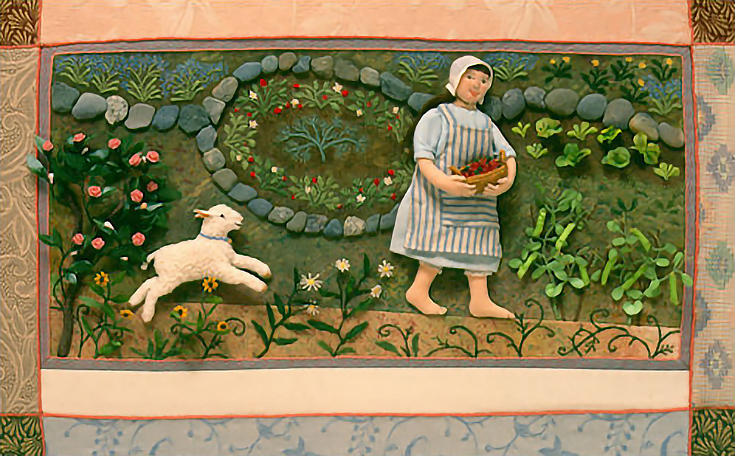 Salley Mavor, author of Felt Wee Folk, is a fabric relief illustrator with a talent for creating highly detailed miniatures and storybook scenes.
Salley Mavor, author of Felt Wee Folk, is a fabric relief illustrator with a talent for creating highly detailed miniatures and storybook scenes.
It took Salley nearly ten years to cultivate and develop her fabric relief technique. A technique so intricate that illustrating a simple child’s book can take up to two years to illustrate.
She uses hand-dyed fabric, wool, and felt along with 3-D objects like wires, cardboard, and wood debris. She then embroiders, hand sews, and assembles each miniature to create meticulously imaginative works of art.
Today, we get to take a look inside Salley’s brain—and we’ll discover where she got her talent and how she found her very unique niche in the art world.
Alyice: How did you get started as an artist?
Salley: My mother had a big influence on my development as an artist. Growing up in her household was like living in a busy hive, with art projects, materials and equipment close at hand. There was always time for art and I never heard her say no to an imaginative scheme. She would help us gather materials and teach us whatever we needed to make an idea come to life.
Alyice: Do you have a fond memory of creating art with your mother?
Salley: For my mother, part of the fun of making things was the physical thrill of interacting with the materials. We lived in a perpetual state of clutter, with the technique du jour in evidence all through the house. One day she had the children clear a path through the living room so that our father could walk through.
Alyice: Did your mom have a specific belief when it came to art?
Salley: In a term paper about art education, for her master’s degree in 1965, she wrote, “The student should be encouraged to find his own way, but this does not mean the void of laissez-faire. Children need a structured exposure to many ways of seeing, doing and thinking. To teach art, the teacher must be an artist. By having confidence in their own abilities, teachers will be able to sensitize children to want to learn and care—not just problem solve. Through intuitive discovery a child will find himself, what he believes and be really free, even in a computer society. By giving students something to do—learn and contemplate what they can understand naturally—will give them the values needed today.”
Alyice: Have you always been able to sew such magnificent works of art?
Salley: Looking back, I have early memories of sewing and constructing things as a child. I would spend hours sewing outfits and creating scenes for my dolls. Once I figured out how to sew on snaps, a world of possibilities opened up. I was especially interested in all things miniature and coming up with ways to decorate and furnish my doll’s environment.
I can remember making a tiny bathroom and looking around the house for shower curtain material. It had to be plastic and water repellant, regular fabric would not do! I took a pair of scissors, went into our bathroom and cut a small piece out of the shower curtain. It took a while for my mother to discover that the corner was cut out, but she was quite open to sacrifice in the name of art.
Years later, in art school, I rediscovered my childhood fascination with working in 3-dementions.
I majored in illustration but never thought I’d make illustrations in a way that could be reproduced effectively. At the Rhode Island School of Design during the 70s, there wasn’t an obvious major for someone like me; someone who was interested in many different materials and methods and I didn’t want to limit myself to a particular discipline.
In the illustration department, however, I could use any materials I wanted as long as my artwork solved the assignment. All I knew was that total abstraction left me hungry for more and I wanted my artwork to be a kind of narrative that viewers could connect to so I used this time in school to teach myself different ways of working which eventually led to an overwhelming interest in fabric and sewing.
Alyice: So how did you find your niche?
Salley: While a student, I started making and selling a line of fabric pins. One day I was listening to a critique as I sewed some peapods during class. My teacher, Judy-Sue Goodwin-Sturges, noticed what I was doing, looked more closely at my work and said, “Why don’t you do this kind of thing for your illustrations? Try sewing them.”
With that simple encouragement, I stopped trying so hard to communicate the pictures in my imagination through a brush or pen. Given permission to work outside of the usual illustration mediums, I found that I was much happier and energized. I was no longer struggling to keep in step. With a needle and thread, I could dance.
For some reason, I’d been under the impression that in art school, one does “serious” fine art and I’d kept my interest in sewing and handcrafts underground. I rediscovered the joy of creating and learned to trust my hands and gut feelings to help work out challenges.
Alyice: What is it about art that gives your life purpose?
Salley: I find the process of working therapeutic and can easily spend a whole day making one little prop, like a miniature basket out of coiled wire and embroidery floss.
One of my favorite activities is sifting through piles of fabric and drawers full of beads, charms and interesting tiny natural or man-made objects I’ve collected over the years. The engrossing, tactile process of creating a picture fills me with a sense of well-being.
Sometimes, I think that the method is more important to me than the satisfaction I feel from viewing the finished result.
When I fell and broke my wrist in this past January and could not physically make art, my blog became my artistic work. I couldn’t sew, but I could type little stories with one hand. Over several months of recuperation, I transferred my creative energy to composing the blog posts.
It was then that I became keenly aware of how my sense of well-being is linked to being involved in some sort of creative activity on a daily basis.
Over the past few months I have reflected on my career and written blog posts about my artistic development and influences. It is rewarding to hear from readers who know of my work through the books I’ve illustrated and to know that people are interested in what I have to show and say.
Alyice: Your work looks very time consuming, how do you conquer design difficulties?
Salley: My work is very time-consuming and each new piece has its own unique challenges to work out during the process. I find that as long as I let my hands take the lead, difficulties can be overcome with enough time and focus.
Alyice: If you could tell other artists one thing, what would it be?
Salley: It is important that each artist find their own voice and individual way of communicating so they feel secure that their artwork is a natural extension of themselves. That is easier said than done but when an artist can move beyond method and materials toward personal expression, there is no competition between kinds of art or individual artists.
Visit Salley’s blog at weefolk.wordpress.com to see her latest creations or stop by her website, weefolkstudio.com, if you’d like to hire her for illustration work.
This post may contain affiliate links.



